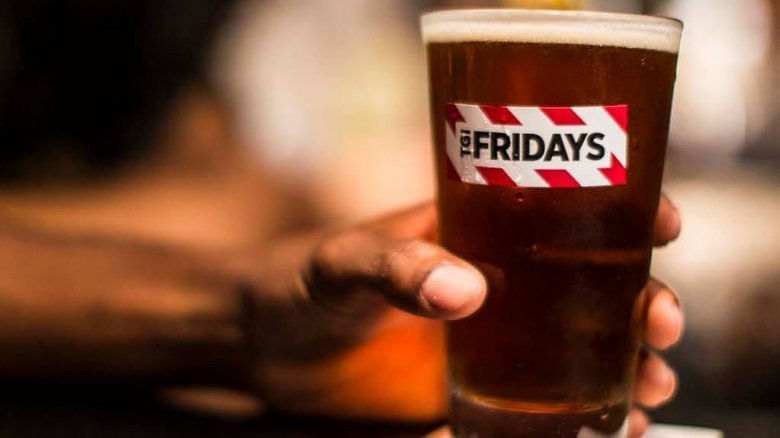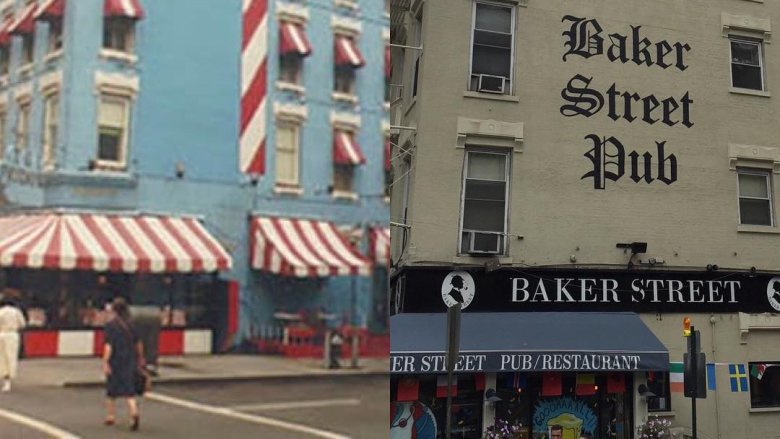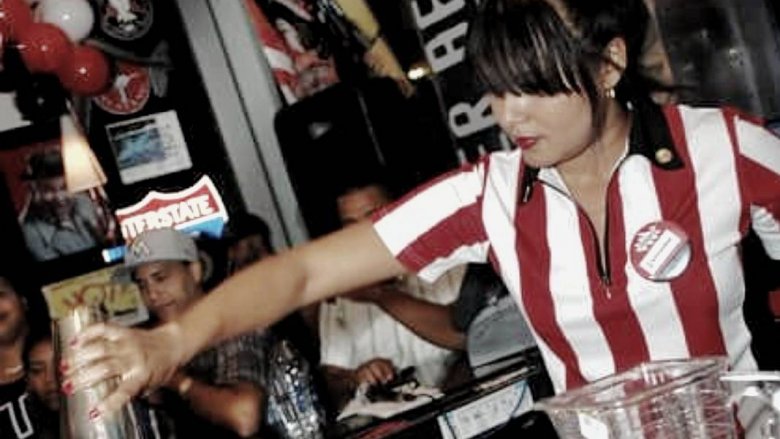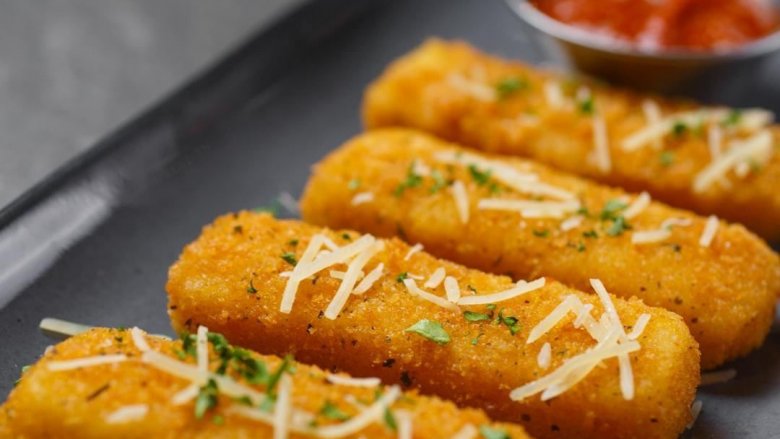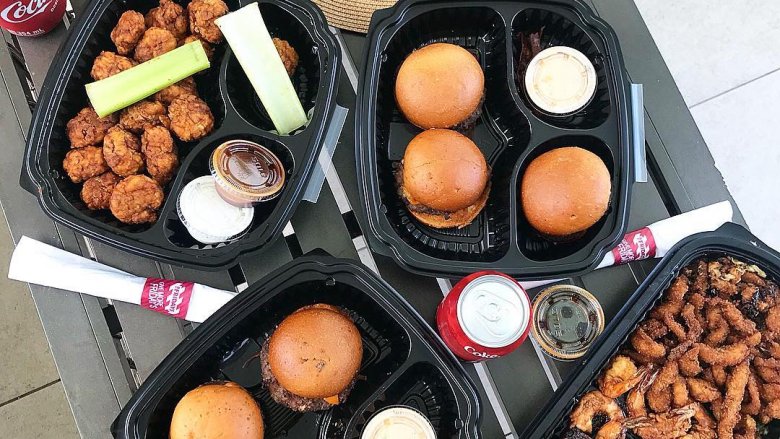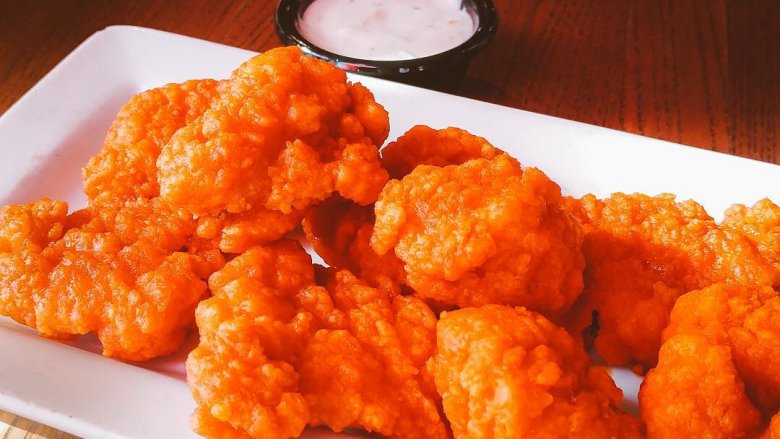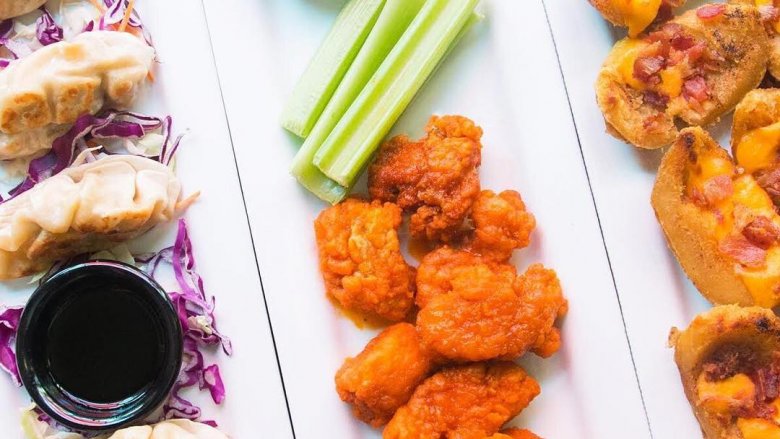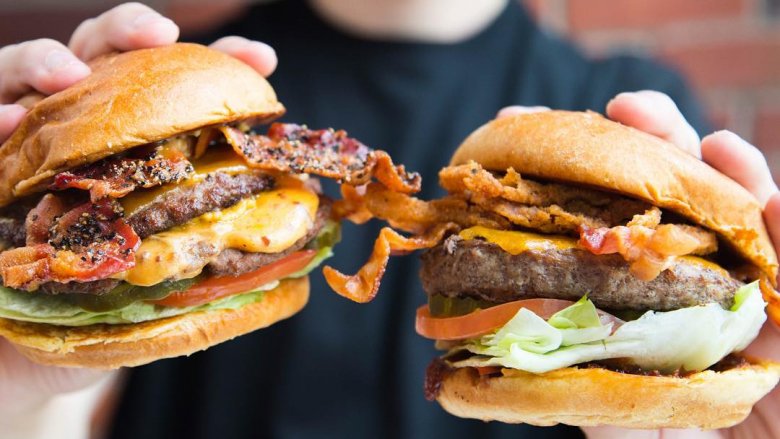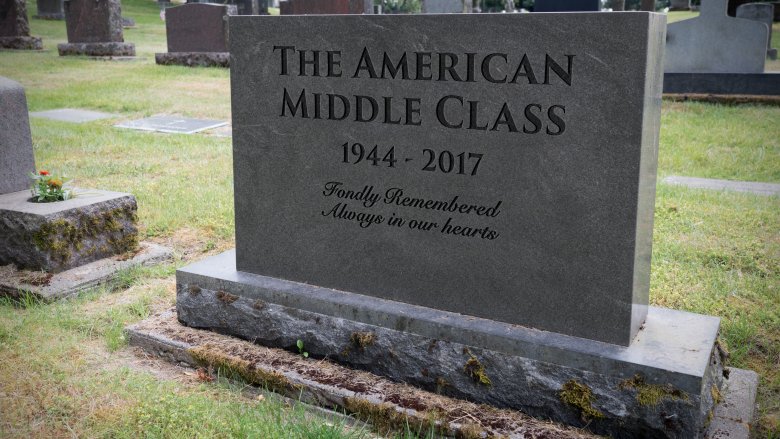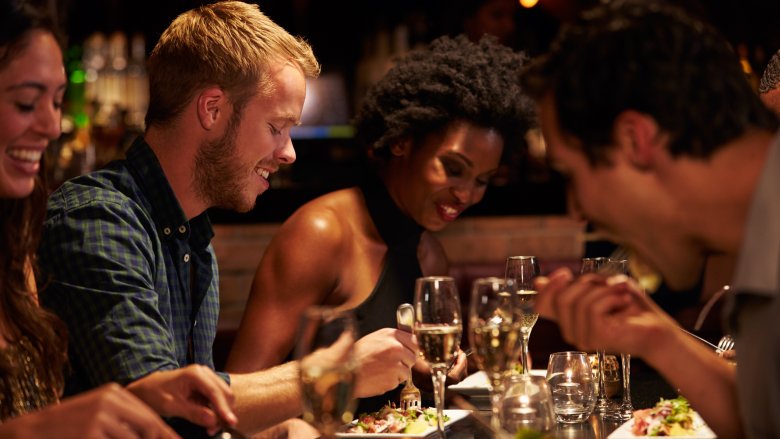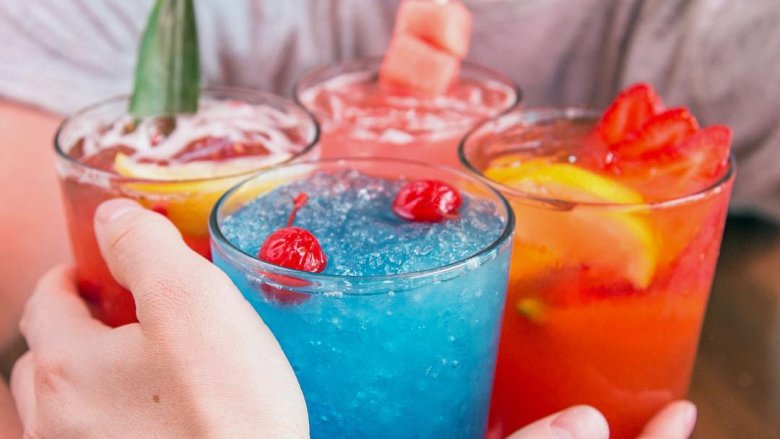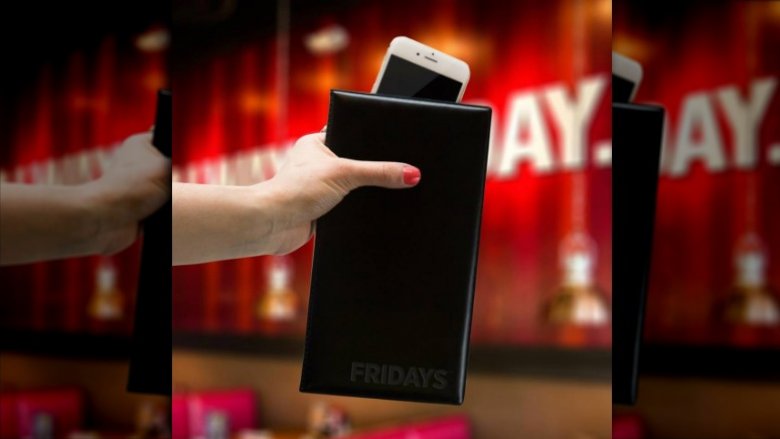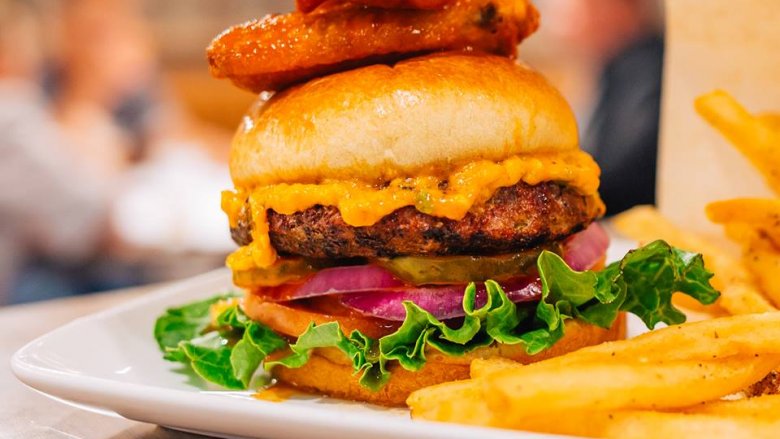The Real Reason TGI Fridays Is Struggling
Be honest — when is the last time you actually ate at a TGI Fridays? In the '80s and '90s, TGI Fridays was a pretty cool place to be, whether you went with your parents on an errand-filled weeknight, or sat with your high school pals as you all shared a giant plate of nachos. Predictable quality, a fun atmosphere, and prices that the average family or teen with a part-time job could afford. Maybe you even used to visit TGI Fridays to enjoy their boisterous bar scene — where candy-stripe shirted bartenders would ring a cowbell or honk an old-timey car horn for all to hear when they collected their tips.
But the times, they are a-changin'. In 2017, TGI Fridays saw a decline in sales of 5.1 percent, and has struggled with growth over the last several years. What's the reason? Revitalized downtown areas have gotten us suburbanites away from the shopping mall, and visiting independent eateries where we munch on artisanal cheeses and sip craft-brewed local beers. Suddenly, a Jack Daniels sauced cheeseburger isn't sounding as cool as it used to. Smartphones and Netflix have us more content to sit at home on a Friday night, and let the food come to us... and the choices have gotten cheaper, better, and hipper, with cheaper being the main driver for many families who are just trying to get by.
Here are all of the reasons that TGI Fridays is struggling.
They've strayed too far from their origins
The first TGI Fridays, located on Manhattan's Upper East Side, wasn't a casual-dining, family restaurant at all. It was a wildly popular singles bar, perhaps the first of its kind, created by a young man with zero restaurant experience, who was "looking to meet girls." Alan Stillman opened the bar when he realized that young adults in 1970s Manhattan could only meet at organized cocktail parties that people hosted in their apartments — bars and public houses at the time were the dominion of beer-swilling men.
Designing a place where young ladies would be comfortable having a cocktail at night with friends, he added reasonably priced food to the menu to keep the paycheck to paycheck customers coming through the doors. And they did. Lines soon formed around the block, and Stillman hired doormen to handle the eager crowds. The bartenders became sought-after mini-celebs, and Stillman claims that he himself was the inspiration for Tom Cruise's character in the movie, Cocktail.
The phenomenon drew franchisees who were eager to recreate the excitement in their own cities. Stillman reports that it was the expansion to Southern towns that saw the bar morph into a family restaurant. Stillman says, "That was the big change. It took six or seven years, but TGI Friday's became a very different animal."
They lost the cool factor
The original TGI Fridays was a fun, homey place, with imitation Tiffany lamps, and walls lined with cluttered antique memorabilia. The look was mimicked for the new franchises, and guests could gawk at strategically placed road signs, live ferns, quirky Americana, taxidermy, and musical instruments. The Commercial Appeal (via Collectors Weekly) called it "a place with so much atmosphere you have to push it aside to get in." People had never seen anything like it, and new locations would open to great fanfare.
Competitors like Ruby Tuesday and Bennigan's copied the kitschy aesthetic, and the gimmick was lampooned in film restaurants like Waiting's Shenaniganz, and Office Space's Chotchkies (where servers were required to wear 15 or more pieces of "flair").
As more chains copied the look, quality began to decline, and the grandmother's attic/saloon decor soon became associated with lousy food. In 2005, TGI Fridays started revamping the decor of its restaurants, discarding the antiques, and losing the servers' flair and candy-striped shirts. New locations focused on minimalism — a protoype location in Texas featured blonde wood, juice stations, and open-mic nights — but can it ever recapture the coolness factor it held in the '70s,'80s and '90s? Restaurant consultant, Darren Tristano told Ad Week, "Today's younger consumer wants to go to a place that their parents didn't patronize, and certainly not a bar and grill from the '70s where you could pick up a flight attendant."
We can blame millennials
Millennials are pretty used to being blamed for the death of any industry or trend that dominated in the '80s or '90s, so it should come as no surprise that they are also marked as one of the leading causes of the downfall of casual-dining chains like TGI Fridays. According to Business Insider, millennials prefer fast-casual chains, like Chipotle or Panera Bread, which offer faster service, cheaper prices, and more customizable options.
QSR reports that it is not only millennials who are flocking to fast-casual restaurants, but also Generation Z, who will quickly replace aging millennials as the demographic that businesses will cater to. And what appeals to Gen Z? The generation that grew up with more adventurous taste buds apparently has an appreciation for authentic global flavors and healthy foods, and gravitates towards spaces where they can linger with friends without the nuisance of a waiter.
So what does this mean for TGI Fridays? With the younger generations predicted to vastly outnumber Baby Boomers and Gen X in the next few years, it seems like pedestrian choices like mozzarella sticks and whiskey-glazed sliders aren't going to cut it much longer.
Delivery is making it worse
Even if millennials do have a hankering for some TGI Fridays' loaded potato skins, Business Insider reports that they are far less likely to come into the restaurant to order them, and will opt for delivery instead. While offering delivery to a demographic that values convenience and time may seem like a no-brainer for casual-dining chain restaurants, the logistics of it require added expenses for the restaurants, who now have to cope with additional insurance, and the cost of employing drivers. Third-party delivery services, like Grubhub or DoorDash (which TGI Fridays uses for 122 locations,) can ease the burden for chains that are anxious to offer delivery, but take quality control out of the company's hands, while also keeping a chunk of the company's take on each order.
And what about drinks? Beverages, especially alcoholic ones, drive sales at casual-dining restaurants. But since you can't have a Tropical Berry Mojito Shaker delivered, TGI Fridays doesn't get to upsell you a cocktail with your meal. One possible solution? A test program run by TGI Fridays in Texas that offered delivery customers a way to get that cocktail after all — but it means two stops for delivery drivers who must fetch the food and mixers at the restaurant, and the proper booze at a nearby liquor store. And yes, the drivers are trained to check for photo ID before they pass off your tequila.
Endless apps is causing endless problems
TGI Fridays launched its Endless Apps promotion in 2014, no doubt to try and rival the price-slashing promos going on at competitor's like Chili's or Applebee's, who offer deals like two entrees and a starter for $20. The Endless Apps deal featured a limited choice of appetizers, like nachos or pot stickers, which guests could continue getting refills of while only paying $10 per choice. No doggie bags, no substitutions, and sharing was discouraged. One Gawker writer put TGI Fridays to the test, and spent 14 hours in a Brooklyn location painfully polishing off eight plates of mozzarella sticks, just to see if they would cut her off. They didn't.
The promotion seemed like an interesting, limited time sort of thing — but then TGI Fridays did the unthinkable, and added the promotion permanently to their menu, with some locations allowing you to now switch up the app you choose for your next refill. What can a seemingly money-losing promotion like bottomless appetizers mean for the quality of food you are getting, or the level of service you will receive from Endless-App-weary waitstaff?
According to many consumer reviews, it's only gone downhill. Complaints include servers not allowing doggie bags for other ordered items, and deliberately ringing in refill plates 30 minutes and more late to encourage guests to give up and leave. Some folks report that the apps you get at some locations are poor quality, and not up to the standards they had remembered from previous years.
The food isn't making the grade
It's not just the Endless Apps that are seeing a downgrade in quality at TGI Fridays. While the chain has vowed to do a complete overhaul of its menu by the end of 2018, with new additions like fire grilled meats and seafood, and larger servings of fan favorites like baby back ribs, it hasn't been enough to win over the hearts of everyone who visits.
Writers from Business Insider made a visit to a Manhattan location to sample the new and revamped menu items, and reported their experience, which included a ho-hum margarita, dry chicken wings, difficult-to-cut ribs, and mediocre potato skins. A newly added veggie burger and red velvet milkshake also failed to make the grade. The mozzarella sticks, however, were given definitive thumbs up.
Noted was the attempt by TGI Fridays to stray from the casual-dining concept, and focus more on their bar and apps. CMO, Stephanie Purdue, told Business Insider, "I think it's all about returning to the roots of Fridays."
People want fresher food
Considering that TGI Friday's has become the place to go for possibly lousy, deep-fried appetizers, the fact is that their food is not perceived to be very healthy. When pitted against fast casual chains that offer fresh ingredients, global flavors, and more ways to customize menu items, TGI Fridays may have to rethink their standardized offerings of frozen-in-the-factory fare. If you visit a Chipotle restaurant, you can see someone making the fresh guacamole using real avocados. Visit a TGI Fridays, and the appetizers look and smell exactly the same as the TGI Fridays branded frozen appetizers available at your local supermarket.
It's not just fast casual restaurants offering potential customers healthier meals with more variety. Grocery chains have now increased the ready-made meals available for purchase, and have increasingly added delivery to the services they offer. Meal delivery kits, like Blue Apron or Dinnerly, give people what they need to create a restaurant-quality meal at home — using fresh ingredients and little to no processed foods. With the young generations expecting healthier fare to be part of a tasty and economical meal, chains like TGI Fridays may be left in the dust.
The death of the middle class
While millennials are criticized for the downward trajectory of casual-dining chains like TGI Fridays, it may actually be the economy that gives us a clearer picture of why these once popular chains are failing to attract more customers.
TGI Fridays has always been a restaurant that was aimed at middle class America. So the decline of the middle class in the US may be what's to blame for the loss of love for restaurants like TGI Fridays. CNBC reports that while 70 percent of Americans consider themselves to be middle class, the actual number of middle class families has been declining for decades, and represents closer to 50 percent of the country.
That means that while some of those formerly middle class families are moving up the class ladder, many are now living paycheck to paycheck — a group who are more likely to opt for a fast food meal than a meal at a casual-dining restaurant like TGI Fridays, where checks average $14 per person. Even families earning six figures can fall into this bracket, especially in more expensive areas of the country. Says MagnifyMoney's, Mandi Woodruff (via CNBC), "Fixed expenses are increasing at a faster rate than incomes, making it harder to live the lifestyle our parents lived."
The rise of indie restaurants
Sure, the middle class is declining, but people gotta eat somewhere, right? So if the lower earners are opting for fast food, where are the remaining middle class folks, and even the upper income earners eating?
At locally owned restaurants, of course! Urbanization, and the revitalization of formerly blighted downtown areas, has paved the way for an uptick in the amount of independently owned establishments opening across the country, particularly in the top ten to 20 major metropolitan areas. Why dine on deep-fried apps in a shopping mall parking lot, when you can enjoy a "farm-to-table" meal that looks like it was prepared by a contestant on Top Chef?
The Nation's Restaurant News addresses a report from consulting firm Pentallect, indicating that independent restaurants are expected to see up to 5 percent growth by 2020 — almost double the amount of growth predicted for national chain restaurants like TGI Fridays.
Consumers surveyed rated independent restaurants as winning in 12 out of 15 attributes studied, praising locally owned establishments for sharing their values, delivering higher quality food and service, and offering more innovative menus and decor. Says Bob Goldin from Pentallect, "People, especially millennials, are moving downtown to more gentrifying neighborhoods, and they're frequenting local establishments that are winning on these factors."
Fake booze and bad press
No such thing as bad publicity? We'd venture to say that's definitely not the case when you are a casual-dining chain that gets busted for selling fake booze to its bar customers.
In 2013, 13 TGI Fridays franchise locations that were all operated by a NJ-based hospitality company were part of a sting operation called "Operation Swill" by the NJ ABC and Division of Criminal Justice. And what did the officers find when they raided the 29 establishments that were involved in the sting? Not only were some switching premium brands with low-cost alcohol, but also truly disgusting trickery like serving rubbing alcohol mixed with caramel coloring instead of scotch, and filling liquor bottles with dirty water. While it was not revealed to the public exactly which of the restaurants were serving the dirty water, we can't imagine there weren't many folks willing to take that gamble. TGI Fridays issued a statement shortly after the humiliating scandal, saying of the allegations "If accurate, they would represent a violation of our company's values and our extensive bar and beverage standards which are designed to deliver the highest guest experience in our restaurants."
Treatment of their employees hurt their brand image
According to YouGov, one of the biggest deal-breakers for customers is finding out that a brand is treating their employees poorly. It's one of the top three reasons people stop frequenting a place, and once that happens, seven in ten will never go back.
And that's why labor scandals for TGI Fridays have been such a big deal. In the wake of news that UK staff would get a portion of front-of-house service charge payments instead of getting a raise for 2018, YouGov saw TGI Fridays "impression score" — basically, how favorably the brand is seen — take a nose-dive.
That's not the only issues they've had when it comes to keeping staff happy. According to Unite the Union, workers in several UK-based TGI Fridays walked out on strike a shocking five times, all over accusations of wage abuses. Things hadn't been much better on the other side of the pond, either. In 2017, TGI Fridays agreed to pay a whopping $19.1 million to settle a lawsuit filed in New York that claimed the chain had failed to pay workers minimum wage, overtime, and that they had mishandled tips. The settlement was a record sum at the time, says WaiterPay, one that involved 28,000 employees.
Is it any surprise that customers don't like a business that doesn't look after their own?
The struggles of the shopping mall are hurting them
Just for a minute, imagine the location of a typical TGI Fridays. It's probably surrounded by shopping, isn't it? It's in a mall or near a mall, and it's likely that's where they're hoping a lot of their customers come from.
But mall traffic is declining, and according to Restaurant Business, more and more people are choosing to do most of their shopping online. That's not just hurting stores, that's hurting the restaurants — like TGI Fridays — who are hoping to cash in on those hungry shoppers. For many restaurants, the fourth quarter of the year is their make-or-break, but now that a huge amount of holiday shopping is done online, that means it wasn't long ago that TGI Fridays made a decision that's now coming back to break them.
Around 2010, TGI Fridays was looking at where to put new locations, and set their sights on the suburban market. They were hoping to capture a client base from suburban malls and their surrounding areas, and according to what CEO John Antioco told Business Insider, that decision made a massive contribution to their declining sales and struggles. They're definitely not alone in the mistake — other casual dining chains like Ruby Tuesday and Applebee's are in the same position — but misery doesn't always love company.
